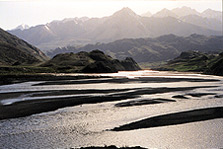


Background:
The Pakistan Wetlands Programme (PWP) aims to promote the sustainable conservation of freshwater and marine wetlands and their associated globally important biodiversity in Pakistan. The programme strategy is based on two sub-sets of objectives. The first will provide the required policy, institutional, technical and financial framework and generate positive public support essential for the mainstreaming of wetlands conservation. The second involves the design and implementation of Sustainable, participatory  management plans for four independent Demonstration Sites, each chosen to be representative of a broad eco-region in Pakistan. It includes specific mechanisms to secure financial sustainability and enhanced replication and proliferation of viable wetlands management interventions in a nation-wide, on-going wetlands conservation initiative.
management plans for four independent Demonstration Sites, each chosen to be representative of a broad eco-region in Pakistan. It includes specific mechanisms to secure financial sustainability and enhanced replication and proliferation of viable wetlands management interventions in a nation-wide, on-going wetlands conservation initiative.
Despite the generally arid nature of Pakistan's climate, the region supports an estimated 780,000 ha of wetlands that cover 9.7% of the total surface area of the country.
In excess of 225 significant wetlands sites are on record in the prototype Pakistan Wetlands GIS Database developed during the PDF (B) Phase of this Project. Nineteen of these have been internationally recognised by the Ramsar Convention Bureau as being of global importance. The diverse assortment of natural freshwater and marine wetlands that occur within Pakistan support unique combinations of biodiversity. The same resource, however, also sustains an estimated 144 million permanent human residents and 3-4 million displaced persons from adjacent countries. The wetlands of the region are, therefore, generally degrading under a broad spectrum of anthropogenic threats that are mainly rooted in poverty but exacerbated by lack of knowledge and mismanagement.
Global Significance
Pakistan's permanent and ephemeral wetlands are globally significant in two ways: first, in terms of the intrinsic value of their  indigenous biodiversity and secondly, as an acute example of the poverty/subsistence-use nexus that constitutes one of the most fundamental threats to biodiversity worldwide. The high global significance of Pakistan's wetlands is attributable to the diversity of species that they support. In all, eighteen threatened species of wetlands dependent mammals are found in the country including the endemic Punjab Urial (Ovis vignei punjabiensis) and Indus River Dolphin (Plantanista minor). Further, twenty threatened bird species are supported by Pakistan's wetlands in addition to twelve reptiles and two endemic species of amphibians. Pakistan's wetlands also support between 191-198 indigenous freshwater fish species, including fifteen endemics and a total of 788 marine and estuarine fish species. The high altitude wetlands, characterised by sites such as Karumbar Lake, situated at an elevation of 4, 150m, and Saucher Lake, at 4,250m on the Deosai Plains, represent a relatively unique category of alpine wetlands that is confined to the Himalaya, Hindukush and Karakoram mountain cordilleras.
indigenous biodiversity and secondly, as an acute example of the poverty/subsistence-use nexus that constitutes one of the most fundamental threats to biodiversity worldwide. The high global significance of Pakistan's wetlands is attributable to the diversity of species that they support. In all, eighteen threatened species of wetlands dependent mammals are found in the country including the endemic Punjab Urial (Ovis vignei punjabiensis) and Indus River Dolphin (Plantanista minor). Further, twenty threatened bird species are supported by Pakistan's wetlands in addition to twelve reptiles and two endemic species of amphibians. Pakistan's wetlands also support between 191-198 indigenous freshwater fish species, including fifteen endemics and a total of 788 marine and estuarine fish species. The high altitude wetlands, characterised by sites such as Karumbar Lake, situated at an elevation of 4, 150m, and Saucher Lake, at 4,250m on the Deosai Plains, represent a relatively unique category of alpine wetlands that is confined to the Himalaya, Hindukush and Karakoram mountain cordilleras.
For more information please refer to Wetlands Programme Document.